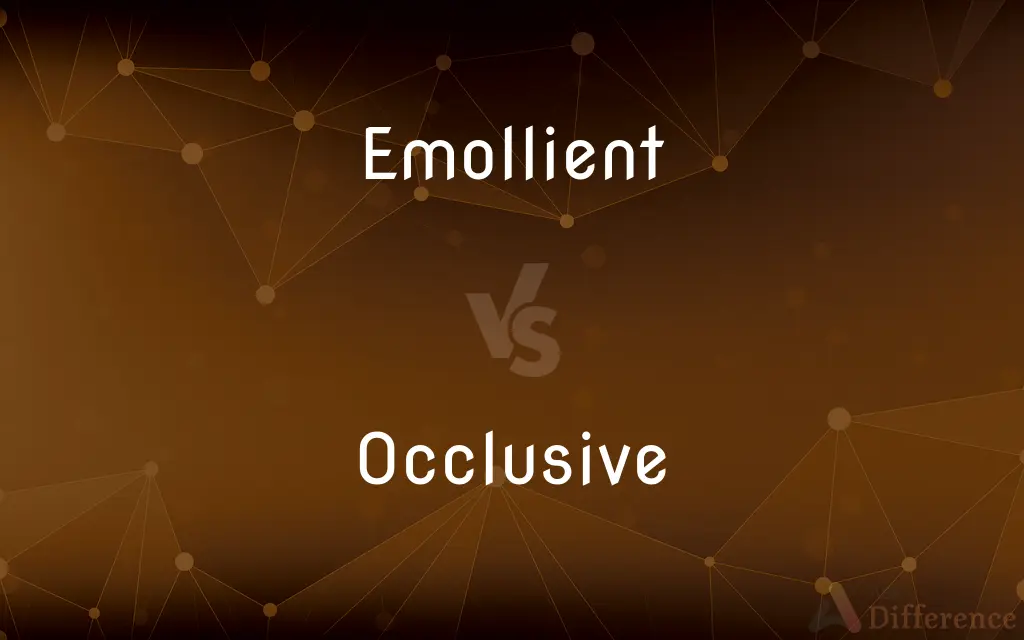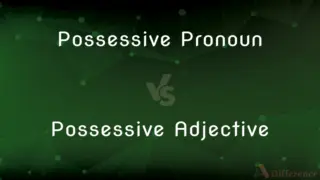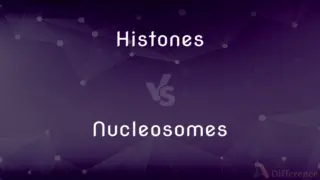Emollient vs. Occlusive — What's the Difference?
By Tayyaba Rehman — Published on October 24, 2023
Emollients soften and smooth the skin, while occlusive create a barrier to prevent moisture loss.

Difference Between Emollient and Occlusive
Table of Contents
ADVERTISEMENT
Key Differences
Emollients and occlusive are two terms frequently mentioned in skincare and dermatology. Emollients refer to substances that soften and smooth the skin. They are used in many skincare products to enhance the skin's texture, making it feel softer and more supple. On the other hand, occlusives are agents that form a barrier on the skin, helping to retain moisture.
While both emollients and occlusives work towards better skin hydration, they function in different ways. Emollients often penetrate the skin's upper layers, filling in gaps between skin cells, thereby softening the skin. In contrast, occlusives remain primarily on the skin's surface, acting like a sealant to lock in moisture and reduce transepidermal water loss.
In skincare formulations, it's not uncommon to find products that combine both emollient and occlusive properties. This ensures that while the skin is being softened and conditioned by the emollients, the moisture within the skin is also being retained efficiently by the occlusives.
However, not all skin types respond the same way to emollients and occlusives. Some individuals may find that while emollients work wonders in making their skin feel smooth, occlusives might feel too heavy or greasy. Conversely, those with extremely dry skin might benefit greatly from the barrier-like function of occlusives.
Comparison Chart
Primary Function
Softens and smooths skin
Creates a barrier to prevent moisture loss
ADVERTISEMENT
Interaction with Skin
Penetrates upper skin layers
Remains on skin surface
Found in
Lotions, creams, and conditioners
Petroleum jelly, waxes, oils
Suitable for
Making skin feel soft and supple
Extremely dry skin types
Feel on Skin
Lightweight and non-greasy
Heavier and can feel greasy
Compare with Definitions
Emollient
Emollient is a substance that softens and conditions the skin.
She added an emollient cream to her skincare routine to combat dryness.
Occlusive
Occlusive agents can feel greasy or heavy on the skin.
She opted for a lighter moisturizer in the daytime and used occlusive products at night.
Emollient
Emollient refers to agents that improve skin texture.
The emollient properties of the lotion made her skin feel silky smooth.
Occlusive
Occlusive is a substance that forms a barrier on the skin.
To lock in moisture, she applied an occlusive balm as the last step of her routine.
Emollient
Emollient can refer to both natural and synthetic ingredients that moisturize.
She preferred skincare with natural emollient ingredients like shea butter.
Occlusive
Occlusive helps in preventing transepidermal water loss.
The occlusive layer of the cream ensured minimal water evaporation from her skin.
Emollient
Emollient often penetrates the upper layers of the skin.
The serum's emollient formula ensured deeper hydration.
Occlusive
Occlusive remains primarily on the skin's surface.
The occlusive ointment felt a bit heavy but was perfect for her dry patches.
Emollient
Softening and soothing, especially to the skin.
Occlusive
Occlusive can refer to ingredients like waxes, oils, and silicones.
Petroleum jelly is a popular occlusive used to seal in moisture.
Emollient
Making less harsh or abrasive; mollifying
The emollient approach of a diplomatic mediator.
Occlusive
Occluding or tending to occlude.
Emollient
An agent that softens or soothes the skin.
Occlusive
An oral or nasal stop.
Emollient
An agent that assuages or mollifies.
Occlusive
That tends to occlude.
Emollient
Something which softens or lubricates the skin; moisturizer.
Occlusive
(phonetics) A phoneme produced by obstructing airflow in the vocal tract, but not necessarily in the nasal tract.
Emollient
(figurative) Anything soothing the mind, or that makes something more acceptable.
Occlusive
(cosmetics) A product that forms a protective film and traps moisture against the skin.
Emollient
Moisturizing.
Occlusive
A consonant produced by stopping the flow of air at some point and suddenly releasing it;
His stop consonants are too aspirated
Emollient
(figurative) Soothing or mollifying.
Occlusive
Tending to occlude
Emollient
Softening; making supple; acting as an emollient.
Emollient
An external something or soothing application to allay irritation, soreness, etc.
Emollient
Toiletry consisting of any of various substances resembling cream that have a soothing and moisturizing effect when applied to the skin
Emollient
Having a softening or soothing effect especially to the skin
Emollient
Emollient is used in products to fill gaps between skin cells.
The moisturizer's emollient components helped diminish the appearance of fine lines.
Common Curiosities
How does an occlusive work?
An occlusive creates a barrier on the skin to prevent moisture loss.
How do emollients interact with the skin?
Emollients often penetrate the skin's upper layers, filling gaps between skin cells, making skin feel softer.
What can be considered as occlusive agents in skincare?
Petroleum jelly, waxes, and certain oils are common occlusive agents.
What is the primary function of an emollient?
An emollient softens and conditions the skin.
Are occlusives suitable for all skin types?
While beneficial for dry skin, occlusives might feel too heavy for some, especially those with oily skin.
What are some examples of emollient ingredients?
Shea butter, fatty acids, and ceramides are examples of emollient ingredients.
Are all emollients lightweight?
While many emollients are lightweight, the feel can vary based on the product formulation.
Can a skincare product contain both emollient and occlusive properties?
Yes, many skincare products combine both emollient and occlusive properties for maximum hydration.
Can using occlusives lead to breakouts?
For some people, especially those with acne-prone skin, certain occlusives might exacerbate breakouts.
Is it good to combine emollient and occlusive in a skincare routine?
For many, combining both can offer enhanced hydration, but individual skin needs should dictate the choice.
Can emollients help with the appearance of fine lines?
Yes, by filling gaps between skin cells, emollients can diminish the appearance of fine lines.
Does an occlusive penetrate the skin like an emollient?
No, occlusives remain primarily on the skin's surface, acting as a barrier.
How can occlusives benefit extremely dry skin?
Occlusives lock in moisture and reduce water loss, making them beneficial for very dry skin.
Can an emollient also have occlusive properties?
Some ingredients can have both emollient and occlusive properties, ensuring skin softness and moisture retention.
Are all occlusives greasy in feel?
Many occlusives can feel heavy or greasy, but the feel can differ based on the specific ingredient or product.
Share Your Discovery

Previous Comparison
Possessive Pronoun vs. Possessive Adjective
Next Comparison
Histones vs. NucleosomesAuthor Spotlight
Written by
Tayyaba RehmanTayyaba Rehman is a distinguished writer, currently serving as a primary contributor to askdifference.com. As a researcher in semantics and etymology, Tayyaba's passion for the complexity of languages and their distinctions has found a perfect home on the platform. Tayyaba delves into the intricacies of language, distinguishing between commonly confused words and phrases, thereby providing clarity for readers worldwide.












































